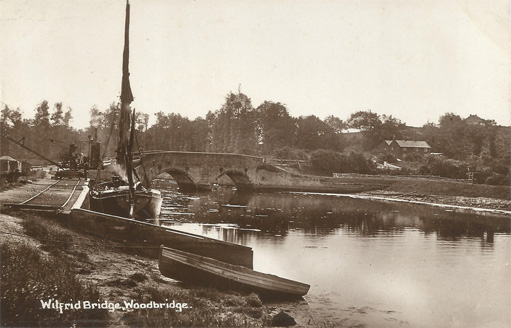The Wilford Bridge is the first crossing point of the River Deben providing access to the Wilford Peninsular.
MELTON'S ROOTS go back as far as the Saxons – probably earlier. The settlement developed along the banks of the Deben, close to the river's first crossing point giving access to the Wilford Peninsular. A courthouse and gaol were constructed on The Street in the 10th century, suggesting the village was becoming an important administrative centre. All was to change in 1575 though, when Thomas Seckford moved the court to Woodbridge, taking many of the associated businesses with it.
In the following years, Melton continued to grow. An iron foundry was built on The Street, a site on the parish border with Ufford became the workhouse for the Wilford and Loes Hundred, which then went on to become the Suffolk County Asylum. Both the iron foundry and the asylum were significant employers in the area, with the latter attracting people from all over the country.
For a snapshot of Melton in the years immediately preceding the war, we can turn to Kelly’s Directory of 1912; it describes the village thus:
“Melton is a large populous village and parish on the River Deben, with a station on the Ipswich and Lowestoft section of the Great Eastern railway. It is one-mile north-east from the adjoining parish of Woodbridge. It is in the South Eastern division of the county known as the Wilford Hundred. It is also in the Woodbridge petty sessional division, union and county court district, Wilford rural deanery, archdeaconry of Suffolk and the diocese of Norwich.
The village is lighted by gas, provided by the Woodbridge Gas Light and Coke Company Ltd, and supplied with water from springs by the Woodbridge District Water Company.
The church of St Andrew was erected in 1867-8 at the cost of £3,500. It is a building of Kentish rag, with Caen and Bath stone dressings in the Decorated style. It was opened in May 1868. It consists of chancel, nave, north aisle, south porch and a south-west tower with spire, containing a clock and 3 bells. The font was brought from the old church and is carved with illustrations of the seven sacraments of the Catholic church. It has seating for 410 people. The tower and nave of the old church, which stands at some distance from the village, are now only used as a mortuary chapel. The churchyard is still used for burials. The living is a rectory, net yearly value £210, with 8 acres of glebe and residence. It is in the gift of the Dean and Chapter of Ely and held since 1908 by the Rev Horatio George Broke MA of University College, Oxford. There is a small Primitive Methodist Chapel, erected in 1860, and also a parish reading room.
Melton Grange is the residence of George Hector Grant Esq JP; Fern Hill, of Harry Filmer Sulivan Esq; Bury Hill, of Frederick Eustace Reade Fryer Esq JP; and the Lodge, of J. A. Burness Esq. The Dean and Chapter of Ely are the lords of the manor. The principal landowner is Capt Walford.
The soil is sandy, and the subsoil is gravel. The chief crops are wheat and barley. The area is 1,417 acres of land, 6 of water, 5 of tidal water and 24 of foreshore. The rateable value is £11,991. The population in 1911 was 2,042, including 113 officials and their families and 817 patients in the asylum. The population of the ecclesiastical parish in 1901 was 1,665.
Post Office: Ernest James Curtis, sub-postmaster. Letters received through Woodbridge arrive at 4:35 am (delivered 7am), 1 pm and 8 pm. They are dispatched at 11:30 am and 8 pm. On Sundays, letters are delivered at 7 am and sent at 8 pm. The letter box at the Railway station is cleared daily at 7:50 pm.
The Suffolk District Asylum stands about one mile from the village on the road to Wickham the County Magistrates in 1827 and opened in 1829 for the reception of pauper lunatics. In 1886, two wings and a water tower were added, gas mains laid throughout and a laundry built at the cost of about £42,000. In 1890 waterworks were erected near the railway station. The water is obtained from boreholes, and thence conveyed in pipes to the asylum. Additional land was purchased in 1900 for the erection of new buildings to hold a higher number of patients, a house for the medical superintendent, dwellings for the staff and an Isolation hospital. The asylum is now available for 900 patients.
A.M. Bernard Esq JP is the chairman of the committee of visitors for the asylum. James Richard Whitwell is the resident physician and superintendent. Stephen George Longworth and John Patrick Francis Waters are assistant medical officers. The Rev. Winwood Swaffield Furze is the asylum chaplain. A. Townshend Cobbold Esq, County Hall, Ipswich is the clerk to the committee of visitors. Henry Gaffney is the clerk and steward.
The Public Elementary School takes both boys and girls. It was enlarged in 1885 and 1894 for a maximum of 258 children. The average attendance is 147. Richard Bentham is the headmaster.”
In addition, Melton had many thriving businesses including: a wheelwright, two builders, four farmers, four publicans, a blacksmith, three grocers, a butcher, baker, carpenter and boot repairer, to name but a few.
The coming of war did not change the overall structure of the village. George Grant of Melton Grange continued as the local magistrate, as did Frederick Fryer of Bury Hill, until his death in October 1917. Richard Bentham, the school headmaster, and James Burness of Melton Lodge were two of the people the village relied on for help and advice; Richard was clerk to the parish council throughout the war. The Reverend Horatio G. Broke left St Andrew’s in 1915 and his place was taken by the Reverend John Herbert Orpen.

